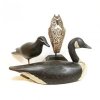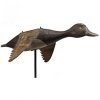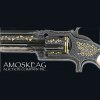Part Two of Mittler Collection Sold
April 8th, 2017
Robert C. Eldred Co., Inc., East Dennis, Massachusetts
Whales and birds and a bit of everything else, in a mere 1500 lots, were the draw at Eldred’s three-day sale of Americana and maritime art April 6-8 in the East Dennis, Massachusetts, gallery. The array of material provided something for every taste, such as scrimshaw, wall murals from an old Cape Cod theater, a very fine pocket globe, and marine paintings.

This 18th-century 2¾" pocket terrestrial globe by London cartographer John Senex (1678-1740) in the original sharkskin case with celestial paper lining is highly detailed and remains in good condition with only slight wear. Marked on one side “A New & Correct Globe of the Earth By I. Senex,” the globe brought $14,400 (est. $500/1000). Senex was also astrologer, geologist, and geographer to Queen Anne.
The highly esteemed Thomas Mittler scrimshaw collection is described by many as the best to come to market since the Barbara Johnson collection nearly 40 years ago, and collectors are eager to have a piece. The collection, which includes many highly desirable teeth, also encompasses the superb artistic and quirky utilitarian objects that appealed to Mittler. It is being sold in three parts at Eldred’s. The first was held last October, the most recent in April, and the final part will be held in August. Each object of the collection is illustrated and described in Nina Hellman’s Through the Eyes of a Collector: The Scrimshaw Collection of Thomas Mittler, a 2015 volume commissioned by Mittler’s widow, Charlotte, in honor of her husband.
The highlight of the three-day event was a 6¾" long tooth attributed to the Lady Wellington Engraver and dated to the first half of the 19th century. The tooth was engraved with a detailed and deeply etched but delicate image of the 1813 battle between the H.M.S. Shannon and the U.S.S. Chesapeake during the War of 1812, also known as the Battle of Boston Harbor. The reverse was decorated with an image of a ship in heavy seas and was entitled “A Gale.” The tooth was estimated at $25,000/35,000 and sold for $72,000 (includes buyer’s premium). The battle, which ended with the capture of the Chesapeake, is pictured in a gently rolling sea, with lightly swirling clouds of smoke and with cannonballs wreaking havoc. The tooth was decorated on both ends with garlands and geometric bands.

The highlight of the scrimshaw was this 6¾" tooth, attributed to the Lady Wellington Engraver and dated to the first half of the 19th century. The tooth is engraved with a detailed and deeply etched but delicate image of the 1813 battle between the H.M.S. Shannon and the U.S.S. Chesapeake during the War of 1812, also known as the Battle of Boston Harbor. The reverse is decorated with an image of a ship in heavy seas and is entitled “A Gale.” The tooth was estimated at $25,000/35,000 and sold for $72,000. The battle, which ended with the capture of the Chesapeake, is pictured in a gently rolling sea, with lightly swirling clouds of smoke and with cannonballs wreaking havoc. The tooth is decorated on both ends with garlands and geometric bands.
The birds were two exceptional John Joseph Audubon (1785-1851) elephant folio prints, each marked “Drawn from nature by J.J. Audubon, F, R, S F, L, S,” and “Engraved, Printed & Coloured by R. Havell,” on paper with a Whatman watermark. Three phone bidders pursued Carolina Parrot, 37¾" x 24¾", a lush depiction of the birds, male, female, and young, that sold for $78,000 (est. $65,000/85,000). The same three phone bidders chased Pileated Woodpecker, 37¾" x 25", which brought $42,000 (est. $18,000/22,000) from the same phone bidder who took Carolina Parrot. Both images came from a Cape Cod estate.

The John Joseph Audubon (1785-1851) elephant folio print is marked “Drawn from nature by J.J. Audubon, F,R,S F,L,S,” and “Engraved, Printed & Coloured by R. Havell,” and is on paper with a Whatman watermark. Three phone bidders pursued Carolina Parrot, 37¾" x 24¾", a lush depiction of the birds, male, female, and young. The print sold for $78,000 (est. $65,000/85,000).

The same three phone bidders who pursued Carolina Parrot chased Pileated Woodpecker, 37¾" x 25", which brought $42,000 (est. $18,000/22,000) from the same phone bidder who took Carolina Parrot. Both images came from a Cape Cod estate.
A ledger for a nine-month voyage in 1866 of the Provincetown whaling schooner Cetacean lists expenses and profits over the course of the voyage. Estimated at $4000/6000, it sold for $1680. It was from a consignor other than the Mittler collection.
 The topper of the jewelry sold was a Patek Philippe man’s 18k gold watch, made in Switzerland around 1960, that sold for $24,000 (est. $4000/5000). The watch retained the original Patek Philippe leather strap with an 18k gold clasp and bore a presentation inscription. An Edwardian diamond and platinum solitaire, 2.43 carats, brilliant cut, sold for $6600 (est. $5000/7000).
The topper of the jewelry sold was a Patek Philippe man’s 18k gold watch, made in Switzerland around 1960, that sold for $24,000 (est. $4000/5000). The watch retained the original Patek Philippe leather strap with an 18k gold clasp and bore a presentation inscription. An Edwardian diamond and platinum solitaire, 2.43 carats, brilliant cut, sold for $6600 (est. $5000/7000).
For information, check the website (www.eldreds.com) or call (508) 385-3116.

A 13-star American flag from the early 19th century or earlier, 39" x 45", was of great interest and sold for $13,200 (est. $1000/1200).

An early 20th-century Grueby vase that managed to escape destruction for over a century came from a rental house on Bass River in Yarmouth, Massachusetts, where it had lived on the floor of the pantry. The 12½" tall vase was designed by George Prentiss Kendrick with a pierced body with nine carved leaf tips and bears the circular faience factory mark. The vase retains an original two-light copper vase cap and neck and was accompanied by the paper shade described in catalog notes as “a wreck” but available to the successful bidder, who got it for $21,600.

This scrimshaw whale’s tooth attributed to Moses R. Denning, a Boston housewright when not at sea, depicts a ship under full sail flying an American flag and a vivid red and blue pennant beneath a starry sky on one side and a highly fashionable woman of the 1820s with a tall comb in her hair on the reverse side. Potted plants with trailing vines are carved beneath the main image on both sides of the tooth. The tooth was a good buy when it realized $18,000 (est. $30,000/50,000).

This polychrome whale’s tooth from the mid-19th century is decorated in the manner of the Ceres Artisan, with a basket-weave band across the bottom, a spread-wing eagle with a shield, and U.S. flags above a sailor with a single-star American flag in one hand and holding hands with a woman with the other. The reverse depicts a well-dressed woman seated on a bench beneath an arch of bowed trees, a schooner off the bow of a full-rigged ship, a crucifixion scene above a tree, the moon and stars, and a tree in full bloom. Estimated at $8000/12,000, the tooth was hammered down to a dealer in the gallery for $19,200. Scrimshanders frequently drew inspiration for their images of women from various publications, including Godey’s Lady’s Book.

The auctioneer’s favorite was a still life of cherry blossoms in a blue and white vase that is unsigned, dated “Sept-21-72,” and attributed to Pennsylvania artist George Cochran Lambdin (1830-1896). Josh Eldred told bidders that the 8" x 6" oil on mahogany panel was his favorite painting in the sale and had drawn much interest as he hammered it down for $3500 (est. $400/600).

Head to Head, The Sandbaggers, a 20" x 30" oil on board by Michael Keane (1948-2015) of southeastern Massachusetts, is signed and dated 1999. It realized $24,000. At the age of eight Keane began an eight-year apprenticeship with landscape artist Edward Harrington. Later in life Keane owned a sandbagger sloop of his own. The painting came from a Duxbury, Massachusetts, collection.
Originally published in the June 2017 issue of Maine Antique Digest. © 2017 Maine Antique Digest





















































